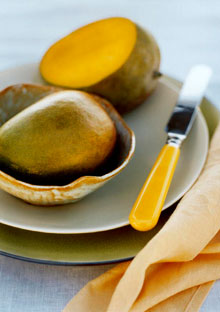The Mango Lesson

Photo: Mikkel Vang
Her surgeon father was austere, formal, remote. But put a mango in his hand and you'd catch a glimpse of the little island boy picking fruit and shooting coconuts out of trees. Joanne Chen savors a memory.
There is a ritual to eating a mango in my family. First you must hold it and appreciate its smoothness and congratulate yourself for picking such a beautiful specimen. Next, you must press your finger against it, and confirm that, yes, it's just the right firmness: This will be a good one. Then you pare off the skin with a sharp knife (my father, a surgeon, did this expertly and quickly, but never quickly enough) and cut the fruit into pieces. Last, you poke the pieces with a toothpick and devour them. As children, my siblings and I would conclude this ritual by fighting over who got the pit—and therefore the honor of eating with our hands. Imagine my indignation, then, a few years back when a publicist for the National Mango Board appeared in my office bubbling with ideas on how to make eating mangoes less messy, quicker, and more convenient. She showed me how to cut crosshatches through its golden flesh and scoop out the dainty cubes. She pulled out from her bag some contraption called a mango slicer, and cut the mango into neat pieces with one fell thump. She informed me that one cup of the fruit has 110 calories, 25 percent of the Daily Value of vitamin A, and 80 percent of vitamin C. "We think Americans will eat more mangoes if we show them how to make it easy," she said.
"I see," I responded, because I knew she meant well. But I didn't see. To me, mangoes aren't meant to be easy. They're a complex fruit, deserving of time and effort. A mango slides around in your palm as you pare it, for example, giving you extra moments to breathe in its sweet, tangy scent. And sticky fingers are part of the fun.
For much of my life, these experiences felt like a family secret. In rural New England, where I grew up in the 1970s and '80s, mangoes were unheard of at the local Stop & Shop. I knew them because my father, who often attended business meetings in Boston, an hour and a half away, would brave the winter chill, rush-hour traffic, and parking headaches to make that extra stop in the crowded streets of Chinatown. "Look what I found!" he would say when he returned, and the five of us would sit down for dinner, anticipating the taste of it at the end of the meal—a taste described as "exotic" and "tropical" by most Americans but comforting and familiar to me.
My mother was originally a city girl from Beijing, but my father grew up in "island country," having moved with his family from southern China to Indonesia when he was young. Sometimes, on a Sunday afternoon, we'd gather round the kitchen table for tea, fruit, and the newspaper, and he'd sketch this fantastical collection of big and small islands on a yellow legal pad. He'd tell us about how he'd shoot at coconuts with his slingshot as a boy and pluck luscious mangoes right off a tree. His parents had no money and eight kids to feed (he always reminded us of this). But out in the wild everything was his to take, and he felt like a prince. I pictured this precocious child left to create his own adventures, and the jungle—with its lizards, squirrels, and abandoned birds' nests—as his playground.



